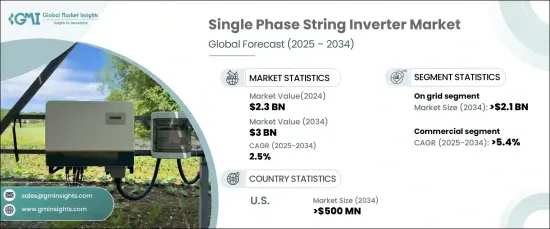
|
市場調査レポート
商品コード
1665368
単相ストリングインバータ市場の市場機会、成長促進要因、産業動向分析、2025年~2034年予測Single Phase String Inverter Market Opportunity, Growth Drivers, Industry Trend Analysis, and Forecast 2025 - 2034 |
||||||
カスタマイズ可能
|
|||||||
| 単相ストリングインバータ市場の市場機会、成長促進要因、産業動向分析、2025年~2034年予測 |
|
出版日: 2024年12月24日
発行: Global Market Insights Inc.
ページ情報: 英文 102 Pages
納期: 2~3営業日
|
全表示
- 概要
- 目次
単相ストリングインバータの世界市場は、2024年に23億米ドルと評価され、2025~2034年にかけて2.5%のCAGRで安定的に成長すると予測されています。
これらのインバータは、中小規模の太陽光発電システムに不可欠であり、主に住宅や小規模の業務用途に使用されています。その主要機能は、ソーラーパネルによって生成された直流(DC)を交流(AC)に変換し、単相電力網に適合させることです。

持続可能性とエネルギー自給に対する意識の高まりは、太陽光発電導入の主要な推進力であり、単相ストリングインバータの需要を煽っています。気候変動への懸念が強まるにつれ、再生可能エネルギー源への移行が、特に住宅セグメントで勢いを増しています。このシフトは、太陽光発電技術の急速な進歩と相まって、市場の成長を促進し、これらの効率的なエネルギーシステムの普及を促しています。
| 市場範囲 | |
|---|---|
| 開始年 | 2024年 |
| 予測年 | 2025~2034年 |
| 開始金額 | 23億米ドル |
| 予測金額 | 30億米ドル |
| CAGR | 2.5% |
接続性別市場セグメンテーションでは、2034年までに23億米ドルを生み出すと予測されるオングリッドシステムに大きな注目が集まっています。オングリッドインバータは、高価な蓄電池を必要とするオフグリッドインバータと比べ、コスト面で大きな優位性があります。これらのシステムは電力会社の送電網とシームレスに統合され、ユーザーは余剰電力をネットメータリング・プログラムを通じて送電網に売電することができるため、電気料金が削減され、購入しやすくなります。二酸化炭素排出量を削減し、化石燃料への依存度を下げる取り組みが増加していることが、系統連系型ソーラーソリューションの採用を後押ししています。
市場はさらに用途別に分類され、住宅用と業務用が堅調な成長の可能性を示しています。特に商用セグメントは、中小企業向けの拡大性とコスト効率に後押しされ、2034年までCAGR 5.5%という目覚ましい成長が見込まれています。単相ストリングインバータは優れた投資収益率(ROI)を実現し、進化するビジネスニーズに合わせてエネルギー生産を拡大する柔軟性を記載しています。さらに、商業地区での設置課題に対応するコンパクトでスペース効率の高い設計が、製品の魅力と普及を高めています。
米国では、単相ストリングインバータ市場は2034年までに5億5,000万米ドルに達すると予測されています。連邦税額控除、州レベルのリベート、金融優遇措置が、国全体の太陽光発電設置を促進しています。送電網の不安定化、停電、異常気象に対する懸念の高まりにより、企業はエネルギーの回復力と安全性を優先するようになっています。企業が持続可能で費用対効果の高いソリューションを求めて運営経費を削減し、エネルギーの独立性を高める中、市場は持続的な成長を遂げる位置にあります。
目次
第1章 調査手法と調査範囲
- 調査デザイン
- 基本推定と計算
- 予測モデル
- 一次調査と検証
- 一次情報
- データマイニングソース
- 市場定義
第2章 エグゼクティブサマリー
第3章 産業洞察
- 産業エコシステム
- 規制状況
- 産業への影響要因
- 促進要因
- 産業の潜在的リスク・課題
- 成長可能性分析
- ポーター分析
- 供給企業の交渉力
- 買い手の交渉力
- 新規参入業者の脅威
- 代替品の脅威
- PESTEL分析
第4章 競争情勢
- イントロダクション
- 戦略ダッシュボード
- イノベーションと技術の展望
第5章 市場規模・予測:接続性別、2021~2034年
- 主要動向
- スタンドアロン
- オングリッド
第6章 市場規模・予測:用途別、2021~2034年
- 主要動向
- 住宅用
- 業務用
第7章 市場規模・予測:地域別、2021~2034年
- 主要動向
- 北米
- 米国
- カナダ
- 欧州
- ドイツ
- イタリア
- オランダ
- 英国
- フランス
- アジア太平洋
- 中国
- オーストラリア
- インド
- 日本
- 韓国
- 中東・アフリカ
- イスラエル
- サウジアラビア
- アラブ首長国連邦
- 南アフリカ
- ラテンアメリカ
- ブラジル
- メキシコ
- チリ
第8章 企業プロファイル
- APsystems
- Canadian Solar
- Enphase Energy
- Fronius International
- Huawei Technologies
- INVTSolar
- NingBo Deye Inverter Technology
- Solaredge Technologies
- SUNGROW
- UTL Solar
The Global Single Phase String Inverter Market, valued at USD 2.3 billion in 2024, is projected to grow at a steady CAGR of 2.5% between 2025 and 2034. These inverters are integral to small and medium-sized photovoltaic systems, predominantly serving residential and small commercial applications. Their primary function is converting direct current (DC) generated by solar panels into alternating current (AC), making it compatible with single-phase electrical grids.

The rising awareness of sustainability and energy independence is a key driver of solar power adoption, fueling the demand for single-phase string inverters. As concerns about climate change intensify, the transition toward renewable energy sources gains momentum, particularly in residential sectors. This shift, combined with rapid advancements in solar technology, is propelling market growth and encouraging the widespread use of these efficient energy systems.
| Market Scope | |
|---|---|
| Start Year | 2024 |
| Forecast Year | 2025-2034 |
| Start Value | $2.3 Billion |
| Forecast Value | $3 Billion |
| CAGR | 2.5% |
Market segmentation by connectivity reveals a significant focus on on-grid systems, which are projected to generate USD 2.3 billion by 2034. On-grid inverters offer substantial cost advantages over their off-grid counterparts, which require expensive battery storage. These systems seamlessly integrate with utility grids, enabling users to sell surplus energy back to the grid through net metering programs, reducing electricity costs and improving affordability. Increasing efforts to lower carbon emissions and reduce reliance on fossil fuels are driving the adoption of grid-connected solar solutions.
The market is further categorized by application, with residential and commercial sectors showing robust growth potential. The commercial segment, in particular, is expected to grow at an impressive CAGR of 5.5% through 2034, bolstered by its scalability and cost efficiency for small to medium-sized businesses. Single-phase string inverters provide an excellent return on investment (ROI) and offer the flexibility to scale energy production in line with evolving business needs. Additionally, compact, space-efficient designs that address installation challenges in commercial spaces are enhancing product appeal and adoption.
In the United States, the single-phase string inverter market is forecasted to reach USD 550 million by 2034. Federal tax credits, state-level rebates, and financial incentives are driving solar photovoltaic installations across the country. Rising concerns over grid instability, power outages, and extreme weather events are prompting businesses to prioritize energy resilience and security. As companies seek sustainable, cost-effective solutions to reduce operational expenses and enhance energy independence, the market is positioned for sustained growth.
Table of Contents
Chapter 1 Methodology & Scope
- 1.1 Research design
- 1.2 Base estimates & calculations
- 1.3 Forecast model
- 1.4 Primary research & validation
- 1.4.1 Primary sources
- 1.4.2 Data mining sources
- 1.5 Market definitions
Chapter 2 Executive Summary
- 2.1 Industry synopsis, 2021 – 2034
Chapter 3 Industry Insights
- 3.1 Industry ecosystem
- 3.2 Regulatory landscape
- 3.3 Industry impact forces
- 3.3.1 Growth drivers
- 3.3.2 Industry pitfalls & challenges
- 3.4 Growth potential analysis
- 3.5 Porter's analysis
- 3.5.1 Bargaining power of suppliers
- 3.5.2 Bargaining power of buyers
- 3.5.3 Threat of new entrants
- 3.5.4 Threat of substitutes
- 3.6 PESTEL analysis
Chapter 4 Competitive landscape, 2024
- 4.1 Introduction
- 4.2 Strategic dashboard
- 4.3 Innovation & technology landscape
Chapter 5 Market Size and Forecast, By Connectivity, 2021 – 2034 (USD Billion & MW)
- 5.1 Key trends
- 5.2 Standalone
- 5.3 On grid
Chapter 6 Market Size and Forecast, By Application, 2021 – 2034 (USD Billion & MW)
- 6.1 Key trends
- 6.2 Residential
- 6.3 Commercial
Chapter 7 Market Size and Forecast, By Region, 2021 – 2034 (USD Billion & MW)
- 7.1 Key trends
- 7.2 North America
- 7.2.1 U.S.
- 7.2.2 Canada
- 7.3 Europe
- 7.3.1 Germany
- 7.3.2 Italy
- 7.3.3 Netherlands
- 7.3.4 UK
- 7.3.5 France
- 7.4 Asia Pacific
- 7.4.1 China
- 7.4.2 Australia
- 7.4.3 India
- 7.4.4 Japan
- 7.4.5 South Korea
- 7.5 Middle East & Africa
- 7.5.1 Israel
- 7.5.2 Saudi Arabia
- 7.5.3 UAE
- 7.5.4 South Africa
- 7.6 Latin America
- 7.6.1 Brazil
- 7.6.2 Mexico
- 7.6.3 Chile
Chapter 8 Company Profiles
- 8.1 APsystems
- 8.2 Canadian Solar
- 8.3 Enphase Energy
- 8.4 Fronius International
- 8.5 Huawei Technologies
- 8.6 INVTSolar
- 8.7 NingBo Deye Inverter Technology
- 8.8 Solaredge Technologies
- 8.9 SUNGROW
- 8.10 UTL Solar


